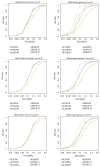Multivariate Cluster-Based Multifactor Dimensionality Reduction to Identify Genetic Interactions for Multiple Quantitative Phenotypes
- PMID: 31380425
- PMCID: PMC6657635
- DOI: 10.1155/2019/4578983
Multivariate Cluster-Based Multifactor Dimensionality Reduction to Identify Genetic Interactions for Multiple Quantitative Phenotypes
Abstract
To understand the pathophysiology of complex diseases, including hypertension, diabetes, and autism, deleterious phenotypes are unlikely due to the effects of single genes, but rather, gene-gene interactions (GGIs), which are widely analyzed by multifactor dimensionality reduction (MDR). Early MDR methods mainly focused on binary traits. More recently, several extensions of MDR have been developed for analyzing various traits such as quantitative traits and survival times. Newer technologies, such as genome-wide association studies (GWAS), have now been developed for assessing multiple traits, to simultaneously identify genetic variants associated with various pathological phenotypes. It has also been well demonstrated that analyzing multiple traits has several advantages over single trait analysis. While there remains a need to find GGIs for multiple traits, such studies have become more difficult, due to a lack of novel methods and software. Herein, we propose a novel multi-CMDR method, by combining fuzzy clustering and MDR, to find GGIs for multiple traits. Multi-CMDR showed similar power to existing methods, when phenotypes followed bivariate normal distributions, and showed better power than others for skewed distributions. The validity of multi-CMDR was confirmed by analyzing real-life Korean GWAS data.
Figures




Similar articles
-
Spatial rank-based multifactor dimensionality reduction to detect gene-gene interactions for multivariate phenotypes.BMC Bioinformatics. 2021 Oct 4;22(1):480. doi: 10.1186/s12859-021-04395-y. BMC Bioinformatics. 2021. PMID: 34607566 Free PMC article.
-
Multivariate Quantitative Multifactor Dimensionality Reduction for Detecting Gene-Gene Interactions.Hum Hered. 2015;79(3-4):168-81. doi: 10.1159/000377723. Epub 2015 Jul 28. Hum Hered. 2015. PMID: 26201702
-
Fuzzy set-based generalized multifactor dimensionality reduction analysis of gene-gene interactions.BMC Med Genomics. 2018 Apr 20;11(Suppl 2):32. doi: 10.1186/s12920-018-0343-0. BMC Med Genomics. 2018. PMID: 29697366 Free PMC article.
-
Epistasis, complexity, and multifactor dimensionality reduction.Methods Mol Biol. 2013;1019:465-77. doi: 10.1007/978-1-62703-447-0_22. Methods Mol Biol. 2013. PMID: 23756906 Review.
-
[Current status of studies on genome-wide gene-gene interactions].Yi Chuan. 2011 Aug;33(8):820-8. doi: 10.3724/sp.j.1005.2011.00820. Yi Chuan. 2011. PMID: 21831799 Review. Chinese.
Cited by
-
Gene-Gene Interaction Analysis for the Survival Phenotype Based on the Kaplan-Meier Median Estimate.Biomed Res Int. 2020 May 9;2020:5282345. doi: 10.1155/2020/5282345. eCollection 2020. Biomed Res Int. 2020. PMID: 32461998 Free PMC article.
-
Spatial rank-based multifactor dimensionality reduction to detect gene-gene interactions for multivariate phenotypes.BMC Bioinformatics. 2021 Oct 4;22(1):480. doi: 10.1186/s12859-021-04395-y. BMC Bioinformatics. 2021. PMID: 34607566 Free PMC article.
-
A Novel Detection Method for High-Order SNP Epistatic Interactions Based on Explicit-Encoding-Based Multitasking Harmony Search.Interdiscip Sci. 2024 Sep;16(3):688-711. doi: 10.1007/s12539-024-00621-2. Epub 2024 Jul 2. Interdiscip Sci. 2024. PMID: 38954231
-
Overview of frequent pattern mining.Genomics Inform. 2022 Dec;20(4):e39. doi: 10.5808/gi.22074. Epub 2022 Dec 30. Genomics Inform. 2022. PMID: 36617647 Free PMC article.
References
MeSH terms
LinkOut - more resources
Full Text Sources

